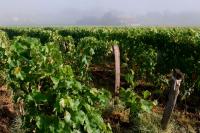
Organic is also advancing in the wine sector: in Italy, in 2020, 4 out of 100 bottles of wine were organic, and the phenomenon is growing rapidly all over the world, both in terms of extension of vines and consumer interest. The report 'La filiera vitivinicola biologica' (The organic wine production chain), a publication of the series dedicated to the organic world promoted by the Ministry of Agriculture, Food and Forestry Policies, provides a snapshot of trends and structural dimensions of the sector, with particular reference to the Italian context. It is produced by Ismea in collaboration with Ciheam Bari, as part of the activities of the National Information System on Organic Agriculture (Sinab).
Census of wine-growing surface area
Globally, of the 7 million hectares of wine-growing area surveyed, 6.7% is cultivated using organic farming production methods, for a total extension that in 2019 reached about 500,000 hectares. The increase in organic vineyards has been tumultuous: +600% in the last 20 years and +114% in the last 10, and sees Europe almost unrivalled, with a surface area that comes to cover 85% of the overall total.
Spain, France and Italy alone, world leaders also in the production of conventional wine, account for 74% of the extension of organic vineyards and have recorded growth rates in the last decade just below the world average. Italy, with an increase of 109% over the decade, is the country that has seen the smallest increase in the area under organic vines. As of 2019, Italy had 107,143 hectares of organic vineyards, of which just under a quarter (23%) are areas in conversion.
4.6% of wine production
On the production side, in the 2019-2020 wine year, the approximately 870,000 tonnes of grapes produced gave rise to 2.2 million hectolitres of organic wine, corresponding to 4.6% of national wine production. At a territorial level, it is clear that in the last decade the Centre-North has been recovering the area gap with the South.
This growth has led to a more balanced distribution of vineyards between the North (22.8%), the Centre (22.5%), the South (25.5%) and the Islands (29.2%). Sicily alone, with just under 30,000 hectares, accounts for around 28% of the total, followed by Apulia (14%) and Tuscany (14%). However, the highest growth rate of the decade was recorded by Piedmont (+406%).
Diffusion of organic wine-growing
To better understand the phenomenon of the spread of organic wine-growing, the Sinab notebook explains, it is also necessary to assess its incidence in relation to the total area under vines. Taking the national figure of 18.8% as a reference, the shares of Calabria (55.2%), Marche (41.9%), Sicily (35%) and Umbria (26.5%) stand out on a regional level, while on the other hand there are great margins for growth in Friuli-Venezia Giulia (6.5%), the Autonomous Province of Bolzano (8.2%), Piedmont (8.4%) and Sardinia (8.8%). Focusing more closely on the provincial level, while the provinces with the largest absolute surface area of organic vineyards are Trapani (14,000 ha), Siena (6,795 ha) and Foggia (5,433 ha), those that in relative terms have the largest percentage of organic vineyards compared to the total surface area under vines are: Ascoli Piceno (50.5%), Crotone (46.6%) and Pisa (38.5%).
Average surface area of more than 6 hectares
There are approximately 18,200 farms directly involved in production, which implies that the average farm area at national level is over 6 hectares. Tuscany, Sicily and Piedmont have average holdings of more than 10 hectares, while, on the other hand, Lazio, Basilicata, Campania and Liguria have holdings with an average vineyard area of less than 2 hectares. Sicily, with 556 thousand hectolitres of organic wine, is by far the most important region in terms of production, followed by Apulia (347 thousand hectolitres) and Tuscany (345 thousand hectolitres).
Growing organic wine demand
In terms of final demand, while consumption of total wine is broadly stable, the demand for organic wine is growing. The main organic wine consuming countries are, in order, Germany, France, the United Kingdom and the United States. But organic wine consumption worldwide still remains a niche, accounting for about 3.5% of the total in terms of quantity. There is room for further robust growth.
Source: Cambia La Terra



